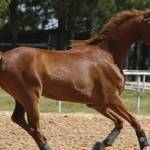Breeding for Fewer Navicular Problems in Horses

The navicular bone is a small bone at the back of the horse’s hoof. Inflammation and arthritic changes in the navicular bone can lead to heel pain in horses, limiting their active years. Linking heel pain to navicular problems is not an exact science, as heel pain can originate in other anatomic structures. Also, some horses with heel pain have no or few navicular changes, and others with extensive changes fail to exhibit signs of pain.
Fragments of bone separated from the lower surface of the navicular bone were seen in radiographs from 325 Belgian Warmblood stallions that were examined in a recent study. The fragments occurred most often in horses with concave (dipping in) or irregular upper surfaces and less often where the upper surface was flat or convex (rounded out).
While all horses in this study were sound, the presence of bone fragments has been positively correlated with clinical navicular disease in some horses. Because shape of the navicular bone border is hereditary, buyers of horses to be used for breeding might want to look for animals with straight or convex navicular border shapes.
However, as with so many other physical traits, navicular shape in foals is probably influenced by several factors. “Breeding the best to the best” is a good practice but never a guarantee that any trait will be produced in offspring.








